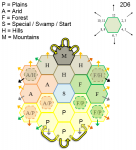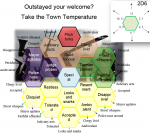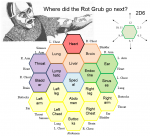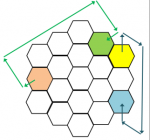Hi - thanks for the commnets!
If you simply want a system to randomly determine what coloured jelly bean is the next out of the jar, then yes, this concept is over engineered.
The idea here is that you have random system that has an underlying structure.
In this system you have a probability gradient introduced by the 2D6 navigation system (up is disfavoured) down is favoured (with a slight left lean). Also, the Hex you are currently in determines which outcomes are possible next. Therefore, past events/outcomes matter. So, there is some continuity in the randomness.
For example, in the below random outdoor terrain generator I made, Plains are favoured (bottom of the Hex Flower) over other terrain (e.g. Woods and Hills) and Mountains are quite disfavoured (top of the Hex Fowler). Also, the way this set up, you can’t go from plain to mountains without first passing through hills. Therefore, while it is randomness, there is also a sense of continuity.

As mentioned in the comments above, you could have a weather Hex Flower that progress from mild weather to severe weather, passing through intermediate states. Also, due to probability structure, and the continuity limitations, you can ensure that severe weather is rarer than mild weather.
The idea is not so complex that it can’t be done in a few minutes (of the seven or so I’ve made to date, the idea took less than 15 minutes to plan. So, yes it requires some thought about what you wish to achieve, but it is not so onerous. Requiring some thought/planning is not a bad thing, indeed I think it is part of the charm of this system.
As an example in my Town Temperature Hex Power Flower, I simply had to think of few ways in which the PCs might get evicted from a town, and who might instigate this. I decide the two main elements who might do this were the clergy and the law, with a minor contribution form Guilds. I then built the system from mild conditions at the bottom to ‘Pitch Forks” at the top.
 Simples.
Simples.
I also enjoyed making this fun but silly Rot Grub tracker; in this idea the 'Heart' is the terminal destination, with major organs being next to it:

:O)





